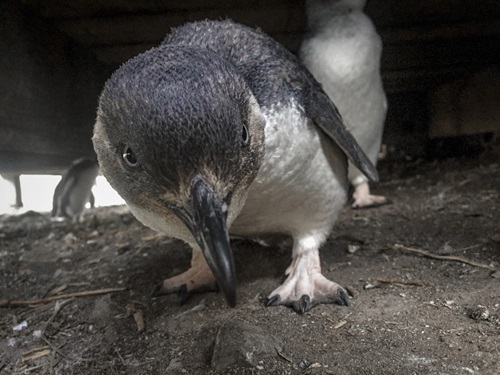CSIRO researchers have found that the fungus, Venturia paralias, specifically attacks the invasive coastal weed called sea spurge (Euphorbia paralias), which threatens nesting sites of native species including little penguins (Edyptula minor), as well as impacting on the wider coastal ecosystem. Current control methods include removing the weed by hand or chemical sprays.
The fungus will be released by CSIRO and Parks Victoria at the world-renowned London Bridge, a natural offshore arch in Port Campbell National Park. The park is a popular tourist destination, with visitors coming to see the pristine coastline, Twelve Apostles and little penguins returning to their beach nests after fishing.
CSIRO scientist Dr Gavin Hunter said sea spurge is problematic for nesting shorebirds, including penguins, as the weed can alter sand dune structure and displace vegetation which could negatively impact nesting sites of shorebirds.
“The weed also has a sap which can cause irritation to animals as well as humans,” Dr Hunter said.
“Sea spurge grows along Australia’s southern coastline and is a concern for coastal ecosystems. We’re hopeful the biocontrol agent will help reduce the dense weed from penguin nesting sites at Port Campbell, and many other beaches along the coastline where the weed occurs.
“There are many challenges with current methods for removing sea spurge so finding a biocontrol agent for the weed was important to complement existing management strategies of hand pulling and chemical sprays that are very labour intensive, costly, and cannot easily be deployed in difficult-to-access beaches.”
CSIRO research technician Ms Caroline Delaisse will release the biocontrol agent at Port Campbell and said the fungus was originally found on the Atlantic and Mediterranean coast of France causing leaf and stem lesions on sea spurge plants.
“The fungus was isolated from these diseased plants and initial tests to explore its host range were performed in France. Following positive results from these tests, the fungus was imported to CSIRO’s quarantine facility in Canberra and studied extensively," Ms Delaisse said.
“Our research found that the fungus is highly specific towards sea spurge. Based on our results, the fungus was approved by the regulator for release in Australia.”
Parks Victoria manages around 70 per cent of Victoria’s coast and is helping CSIRO release the fungus at several sites, in addition to Port Campbell National Park.
Parks Victoria Program Leader for Marine and Coasts Mr Mark Rodrigue assisted in the first releases of the fungus in Victoria and said this was an exciting advancement in weed control that would help protect the health of Victoria’s beautiful coast and native animals, such as little penguins and plants that depend on beach and dune habitats.
“If it successfully establishes, the biocontrol will be particularly important for managing this highly invasive weed in the more remote parts of the coast where access is very difficult for manual or chemical control,” Mr Rodrigue said.
“CSIRO has paved the way for land managers like Parks Victoria and volunteers to safely target areas of sea spurge infestation, with solid science and comprehensive guidelines developed to support us.”
A prolific seed producer, a mature sea spurge plant can produce up to 20,000 seeds per year and can grow anywhere on the beach above the high-water mark, taking over sand and dune vegetation.
This project has been financially supported by the NSW Government as part of nearly $500,000 in funding targeting four weed species including sea spurge.
Sea spurge is an introduced plant from Europe that has invaded coastal ecosystems from Geraldton north of Perth in Western Australia through to the mid north coast of New South Wales and around Tasmania’s coastline.
- CSIRO is calling for volunteers to help with the biocontrol release program on beaches infested with sea spurge in Victoria and Tasmania. To participate in community releases, seek approval from the land manager or owner in the first instance and then contact CSIRO scientists Gavin Hunter (gavin.hunter@csiro.au) or Caroline Delaisse (caroline.delaisse@csiro.au).

